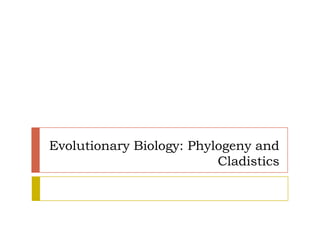Evolutionary biology
•Descargar como PPTX, PDF•
2 recomendaciones•3,496 vistas
Denunciar
Compartir
Denunciar
Compartir

Recomendados
Más contenido relacionado
La actualidad más candente
La actualidad más candente (20)
Contribution of systematics to biology by noor zada

Contribution of systematics to biology by noor zada
Destacado
Destacado (20)
Comparing the Codes: Zoological and Botantical Nomenclature

Comparing the Codes: Zoological and Botantical Nomenclature
Evolution as a Tool for Understanding and Designing Collaborative Systems

Evolution as a Tool for Understanding and Designing Collaborative Systems
From Molecules to Morality: The Evolution Of Altruism

From Molecules to Morality: The Evolution Of Altruism
Definitions and mcqs on branches of Biology by Sajid Ali Talpur

Definitions and mcqs on branches of Biology by Sajid Ali Talpur
Similar a Evolutionary biology
Similar a Evolutionary biology (20)
Animal Morphology : Animal Classification, Phylogeny and Organization

Animal Morphology : Animal Classification, Phylogeny and Organization
Último
Making communications land - Are they received and understood as intended? webinar
Thursday 2 May 2024
A joint webinar created by the APM Enabling Change and APM People Interest Networks, this is the third of our three part series on Making Communications Land.
presented by
Ian Cribbes, Director, IMC&T Ltd
@cribbesheet
The link to the write up page and resources of this webinar:
https://www.apm.org.uk/news/making-communications-land-are-they-received-and-understood-as-intended-webinar/
Content description:
How do we ensure that what we have communicated was received and understood as we intended and how do we course correct if it has not.Making communications land - Are they received and understood as intended? we...

Making communications land - Are they received and understood as intended? we...Association for Project Management
Último (20)
Unit-V; Pricing (Pharma Marketing Management).pptx

Unit-V; Pricing (Pharma Marketing Management).pptx
Food safety_Challenges food safety laboratories_.pdf

Food safety_Challenges food safety laboratories_.pdf
Micro-Scholarship, What it is, How can it help me.pdf

Micro-Scholarship, What it is, How can it help me.pdf
This PowerPoint helps students to consider the concept of infinity.

This PowerPoint helps students to consider the concept of infinity.
Making communications land - Are they received and understood as intended? we...

Making communications land - Are they received and understood as intended? we...
Unit-IV; Professional Sales Representative (PSR).pptx

Unit-IV; Professional Sales Representative (PSR).pptx
HMCS Max Bernays Pre-Deployment Brief (May 2024).pptx

HMCS Max Bernays Pre-Deployment Brief (May 2024).pptx
Python Notes for mca i year students osmania university.docx

Python Notes for mca i year students osmania university.docx
Evolutionary biology
- 1. Evolutionary Biology: Phylogeny and Cladistics
- 2. History Taxonomists have sought to construct a system that would reflect evolutionary relationships. Use morphology to recognize and construct species
- 3. History Grande (2004) Proposes that we view morphology and morphological variations in three ways Taxonomic Ontogenic Individual Ability to interbreed Biological species concept Evolutionary species concept
- 4. Species Concept Morphological Species Generally used morphological criteria because this is how most individuals have been compared. Biological Species Sexually interbreeding or potentially interbreeding group of individuals normally separated from other species by the absence of genetic exchange. Evolutionary Species species as an evolutionary entity.
- 5. Phylogeny Species evolve from existing species. Classification of species Homology 2 species bearing the same phenotype caused by common ancestry for the same genotype. Parallelism 2 species with the same phenotype descended from a common ancestor w/ different phenotype and genotype Convergence 2 species with the same phenotype whose common ancestor is very far in the distant past.
- 6. What is Cladistics? Method of hypothesizing evolutionary relationships among organisms. Based upon the analysis of traits shared by organisms. Cladogram: represents evolutionary relationships. Willi Hennig 1950 German zoologist
- 8. Assumptions of Cladistics The Characteristics of organisms change over time. All organisms are related by a descent from a common ancestor There is a bifurcating or branching pattern of lineage and splitting.
- 9. The Principle of Parsimony The principle of parsimony reasons that given several solutions to a problem, the simplest one should be accepted. The principle of parsimony does not: Provide absolute truth Necessarily reveal the true phylogeny The principle of parsimony does: Reduce conjecture Indicates those cladistic groupings best supported by the available data
- 10. Understanding Cladogram The root of Cladogram represents the ancestral lineage and the tips the descendants. Branching points in the cladograms are called nodes and represents speciation events. Part of each lineage’s history is unique to it alone. Each lineage has ancestors that are unique and ancestors that are shared with other lineages. A B C D E F TIME speciation Cladogram or Phylogenetic Tree TAXA
- 11. Understanding Cladograms Clade: a group comprising an ancestral lineage and all its descendant lineages.
- 12. Characters Inheritable feature of an organism. Physical characteristics (morphology) Genetic sequences Behavioral traits
- 13. Characters Homologous characters A character possessed by two or more organisms due to their sharing of a common ancestor.
- 14. Characters Homoplasy Similar characters in different taxa inferred to have arisen through convergent evolution, not a common ancestor. No use in cladistics
- 17. Plesiomorphy Considered to be ancestral or less derived Apomorphy Features considered to be derived from an ancestral clade Synapomorphy An apomorphic feature that defines a clade.
- 18. Monophyletic group A group consisting of: A common ancestor All descendants of that common ancestor
- 24. Paraphyletic group A monophyletic grouping that certain descendent tax have been removed from due to their possession of additional synapomorphic characters.
- 25. Constructing a Cladogram Outgroup Method Works by identifying tow groups of taxa Ingroup: group being studies Outgroup: for the establishment of plesomorphic and apomorphic character states in the ingroup The outgroup should comprise taxa closely related to the ingroup so homologous characters can be established
- 26. Character states and Character Matrix notochord vertebrae jaws skull lung enamel 4 true limbs Outgroup 0 0 0 0 0 0 0 Tunicate 1 0 0 0 0 0 0 lamprey 1 1 0 1 0 0 0 Cladoselache 1 1 1 1 0 0 0 trout 1 1 1 1 1 0 0 lungfish 1 1 1 1 1 1 0 present 1 absent 0
